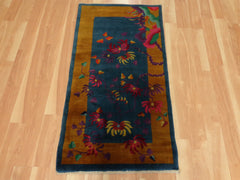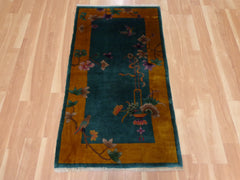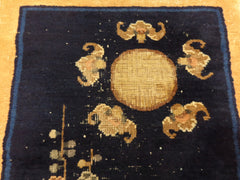Chinese Rugs
What is a Chinese Rug?
An authentic Chinese rug is a hand-knotted rug made in China. The earliest surviving examples of Chinese rugs have been dated to the 17th century at the end of the Ming dynasty. They are woven with Persian knots, typically with wool or silk pile on a cotton foundation. Antique Chinese rugs are among the most easily identifiable antique Oriental rugs with a variety of designs including medallions and pictorial motifs with dragons, phoenixes, trees and other Chinese symbols. Colors were soft and simple in these rugs, with blue, cream and gold.
 Chinese rugs are unique because up until around the 19th century their rugs were woven strictly for internal consumption. Because of this, many of the designs we see in antique Chinese rugs accurately represent Chinese beliefs and culture, more so than a typical Persian city rug woven in the same time period. This is because other rug weaving countries were catering more toward Western tastes.
Chinese rugs are unique because up until around the 19th century their rugs were woven strictly for internal consumption. Because of this, many of the designs we see in antique Chinese rugs accurately represent Chinese beliefs and culture, more so than a typical Persian city rug woven in the same time period. This is because other rug weaving countries were catering more toward Western tastes.
Art Deco Chinese Rugs
Once the rug market in China opened up to outside influence, brighter colors and more open fields were incorporated into Chinese rugs. Specifically, a period arose in which Art Deco style rugs became highly desired. Art Deco describes a style of visual arts that first appeared in Paris before WWI. This style was influenced by both Cubism and Fauvism.
New, exotic colors of magenta, purple and turquoise were found in these rugs  with a solid background and contrasting solid border. Traditional Chinese motifs were still used in Art Deco rugs such as vases, flowers, and butterflies. Both Walter Nichols and Helen Fette, two Americans, joined this movement and began producing popular Art Deco Chinese rugs in China in the 1920's.
with a solid background and contrasting solid border. Traditional Chinese motifs were still used in Art Deco rugs such as vases, flowers, and butterflies. Both Walter Nichols and Helen Fette, two Americans, joined this movement and began producing popular Art Deco Chinese rugs in China in the 1920's.
Nichols Rugs
Nichols Chinese rugs are distinguishable by their stiffer and denser nature. They are denser for several reasons including the use of machine spun yarn, strong cotton used in the foundation threads, and the tightly packed knots used in weaving the rugs. Nichols Art Deco carpets are known around the world and are still highly desired by designers and collectors today.

Fette Rugs
In the 1920's Helen Fette and Chinese rug manufacturer Li Meng Shu formed the Fette-Li Company and produced rugs in the Peking area. These carpets are easily recognized as a slightly floppier version of a Nichols rug. This is because they employed thinner cotton warps in the foundation. True Nichols and Fette rugs should have tags or stamp marks, however because of the current ages of these rugs general wear, tear and repairs may have since made the tags and stamps illegible. The Great Depression and WWII both contributed to the demise of the Art Deco style rugs woven in China.
Symbols in Chinese Rugs
Many of the symbols found in Chinese carpets are derived from religious sources including Taoist and Buddhist beliefs. Taoism goes back to at least the 4th century BC. Some of the most popular symbols used in Chinese rugs include the butterfly, Fo, a pair of cranes, painting scrolls, and bats. For a thorough list of symbols found in all types of Oriental rugs, see our guide to Oriental rug motifs.
Peony: Prosperity and wealth
Bamboo: Purity
Dragons: Power
Bats: Happiness and good luck
Horses: Success
Phoenix: Immortality
Cranes: Longevity
Deer: Longevity
Clouds: Future
Vase: Peace and Harmony
Books: Knowledge
Shou: Long Life
Butterflies: Happy marriage
Lotus: Purity
Wheel of Law
Two Fish
Lyre (Harp)
Chessboard
Colors in Chinese Rugs
Red: Happiness
White: Purity
Blue: Immortality
Pink: Love
Yellow: Royalty
Black: Solemnity
Green: Life





















